The AMD Radeon RX 5500 XT Review, Feat. Sapphire Pulse: Navi For 1080p
by Ryan Smith on December 12, 2019 9:00 AM EST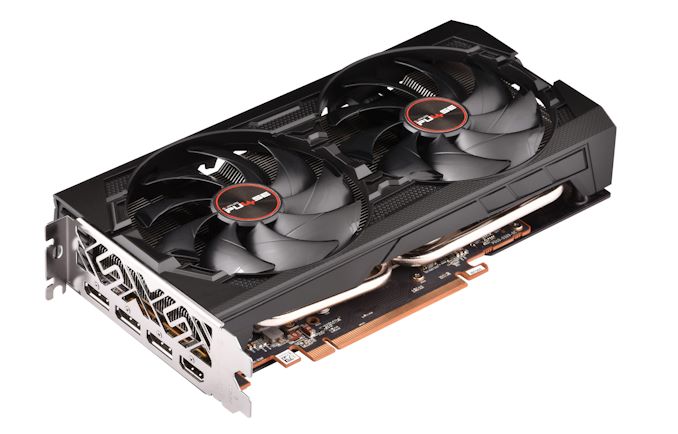
2019 has been a tremendous year for AMD on all fronts. Their CPU division has, of course, been flipping tables left and right across consumer, server, and workstation CPUs. Meanwhile the GPU division has spent their year wrapping up and shipping their Navi GPUs, the first parts utilizing their new RDNA architecture. Now, as the rest of 2019 quickly runs by, AMD’s GPU division is going to get in one final word with the launch of their new mainstream, 1080p-focused Radeon RX 5500 XT cards.
The launch of the 5500 XT has been sort of a weird path for AMD. The company first announced the overarching Radeon RX 5500 series back at the start of October. That announcement was OEM-centric, with AMD announcing the parts that their OEM partners would be shipping in desktops and laptops for the holiday season. Retail cards were part of AMD’s plans as well, of course, but those received a rather nebulous “Q4 2019” launch date. But now with less than two weeks to go until Christmas, the retail RX 5500 cards are here at last – and not a moment too soon.
Launching today are AMD’s Radeon RX 5500 XT cards. These cards are aimed at the sub-$200 market for 1080p gaming, effectively (and finally) replacing AMD’s long-lived Radeon RX 580 and RX 570 cards, and going head-to-head with NVIDIA GeForce GTX 1650 and GTX 1660 families. As is typical for AMD in this price range, the company is actually launching two different configurations of the RX 5500 XT: we’re getting both 8GB cards, as well as 4GB cards as a budget option. Both cards are clocked the same, but as we’re entering 2020, the ramifications of 4GB of VRAM versus 8GB are great enough that it creates some real differences between the cards. The 8GB RX 5500 XT will be taking up the all-important $199 slot, while the 4GB RX 5500 XT will hit the shelves starting at $169.
Underpinning the new cards is AMD’s new Navi 14 GPU. As has been the case with lower-end GPUs in past generations, AMD has taken the constituent parts of their Navi architecture and assembled a smaller, cheaper, and less power-hungry GPU that’s better suited for the sub-$200 market. In the process Navi 14 forgoes some CUs, some ROPs, and some memory bandwidth compared to the original Navi 10, but it retains all of the features of the underlying RDNA (1) architecture, including the efficiency improvements AMD has made there. And, for that matter, it gets the full-fat media processing block as well.
In terms of die size and transistor counts, AMD has dropped about 3.9B transistors from Navi 10, which comes to 38% fewer transistors overall. This translates into a die size of 158mm2, an almost perfectly matched 37% smaller than Navi 10. Compared to AMD’s previous generations of parts, comparisons are a bit rocky since performance targets and die sizes have gone up overall, but this works out to a transistor count about 12% higher than Polaris 10/20/30, in just 70% of the space. Polaris 11 (used in RX 460/560) might be a more apt comparison here, in which case AMD has increased their transistor count by 113% while only increasing the die size by 28%.
These improvements come thanks to TMSC’s 7nm process, of course. The heart of AMD’s entire next-generation product stack across CPUs and GPUs for 2019, AMD is once again using this process for their latest Navi GPU. This remains a critical edge for AMD on a competitive basis, as NVIDIA is still using TSMC 12nm – a 16nm-derrived process – for their GPUs. This gives AMD the ability to lay down smaller transistors operating at lower power levels, with the trade-off being that 7nm is a younger, more expensive process. And, if reports are to be believed, one that TSMC’s customers are jockeying to secure wafer starts due to very high demand.
| AMD Radeon RX Series Specification Comparison | ||||||
| AMD Radeon RX 5500 XT | AMD Radeon RX 5700 | AMD Radeon RX 570 | AMD Radeon RX 560 | |||
| CUs | 22 (1408 SPs) |
36 (2304 SPs) |
32 (2048 SPs) |
16 (1024 SPs) |
||
| Texture Units | 88 | 144 | 128 | 64 | ||
| ROPs | 32 | 64 | 32 | 16 | ||
| Base Clock | 1607MHz | 1465MHz | 1168MHz | 1175MHz | ||
| Game Clock | 1717MHz | 1625MHz | N/A | N/A | ||
| Boost Clock | 1845MHz | 1725MHz | 1244MHz | 1275MHz | ||
| Throughput (FP32) | 5.2 TFLOPs | 7.95 TFLOPs | 5.1 TFLOPs | 2.6 TFLOPs | ||
| Memory Clock | 14 Gbps GDDR6 | 14 Gbps GDDR6 | 7Gbps GDDR5 | 7 Gbps GDDR5 | ||
| Memory Bus Width | 128-bit | 256-bit | 256-bit | 128-bit | ||
| VRAM | 4GB/8GB | 8GB | 4GB | 4GB | ||
| Transistor Count | 6.4B | 10.3B | 5.7B | 3B | ||
| Typical Board Power | 130W | 180W | 150W | 80W | ||
| Manufacturing Process | TSMC 7nm | TSMC 7nm | GloFo 14nm | GloFo 14nm | ||
| Architecture | RDNA (1) | RDNA (1) | GCN 4 | GCN 4 | ||
| GPU | Navi 14 | Navi 10 | Polaris 10 | Polaris 11 | ||
| Launch Date | 12/12/2019 | 07/07/2019 | 04/18/2017 | 05/2017 | ||
| Launch Price | $199/$169 | $349 | $169 | $99 | ||
Curiously and atypically for an upper-tier XT-type part, AMD is not using a fully-enabled Navi 14 GPU here. While AMD has never officially confirmed the complete specs of Navi 14, we know from other Navi 14 products – particularly, the Radeon Pro 5500M parts going into Apple’s laptops – that Navi 14 comes with 24 CUs. So a 22 CU part by contrast is an unexpected castration, though ultimately it doesn’t affect performance too much. AMD hasn’t specifically said why they’re not using all 24 CUs, but given how price sensitive this market is and how popular TSMC’s 7nm process has been, I would not be surprised if AMD is aiming to get as many useful dies as they can off of their Navi 14 wafers.
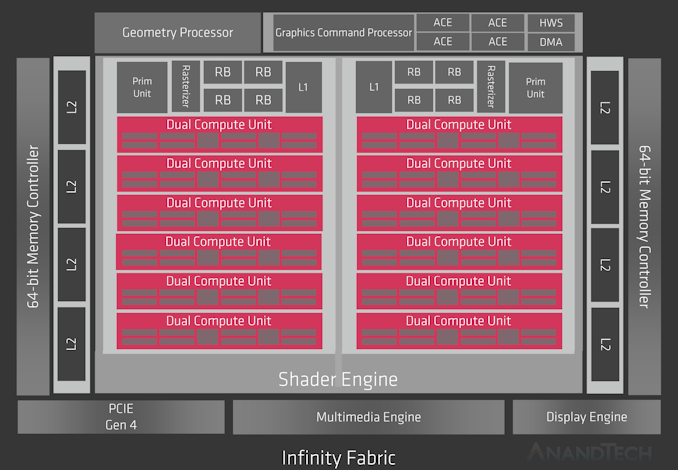
Navi 14 Block Diagram (Unofficial)
At any rate, the RX 5500 XT joins AMD’s family underneath the RX 5700, with 14 fewer CUs (-39%) than AMD’s next best card. However, while the CU counts are down, the clockspeeds will be up slightly, with the RX 5500 XT carrying a game clock of 1717MHz, 92MHz (6%) higher than the RX 5700. Similarly, the maximum boost clock is higher as well, to 1845MHz.
In terms of overall GPU performance then, at full clockspeeds the RX 5500 XT has a peak compute/shader throughput of 5.2 TFLOPs. This is 35% below the peak rate of the RX 5700, and is fairly typical for the kind of jump we see between card tiers.
Meanwhile on the memory side of matters, the RX 5500 XT gets a narrower memory bus as well. Coming off of the RX 5700 series and its 256-bit bus, AMD’s mainstream cards instead come with a 128-bit memory bus. However, that is the only change for memory; AMD will be using GDDR6 for these cards as well. So while the effective drop in memory bandwidth relative to the RX 5700 is significant – going from 448GB/sec to 224GB/sec – it will be the first time that GDDR6 has shown up in a sub-$200 AMD video card. As a result, the RX 5500 XT still has access to a good deal of memory bandwidth, and in this respect should punch above its weight compared to earlier 128-bit bus cards. As for total memory capacity, as previously mentioned AMD and its partners are shipping both 8GB and 4GB cards as performance and value options respectively.
Finally, AMD has set the total board power (TBP) for these cards at 130W. This is notably lower than their OEM counterparts, which ship with similar performance specifications, but a 150W TBP. The OEMs cards admittedly had us a bit worried there – 150W was uncomfortably high, and only a bit lower than the 180W TBP of the RX 5700 – so it’s good to see that AMD is being a bit more aggressive in curtailing power use for their retail cards, thereby boosting their power efficiency. Still, on paper the RX 5500 XT is set to deliver 65% of the RX 5700’s performance for 72% of its power budget, so we’ll have to see what the final power figures look like. And, for that matter, if 130W is enough for the 5500 XT to sustain its high clockspeeds, or if the cards will need to back off a bit to meet their power limits.
Product Positioning & The Competition
Within AMD’s product stack, the new Radeon RX 5500 XT cards are decidedly aimed at the 1080p market. Whereas the 5700 series cards were mostly aimed at 1440p – and delivered well in that respect – the RX 5500 XT doesn’t have the kind of performance to keep up there. Instead, the RX 5500 XT should be able to game at 1080p with few (if any) compromises, especially on the more spacious 8GB card.
Meanwhile, although AMD does have reference RX 5500 series cards, which is what they’ve been shipping to OEMs for the past couple of months, we won’t be seeing these cards in retail. Instead, today’s launch, which is very much a hard launch, is purely driven by the board partners, who are releasing their fully custom designs today. As these are sub-$200 cards we won’t be seeing anything too exotic – mostly the usual variations on two and three fan designs – though factory overclocked cards will be peppered into the mix.
And while this is a hard launch, I’m doubtful we’ll see the first batches of RX 5500 XT cards remain in stock for long. Looking at sales numbers and inventories for existing cards ahead of today’s launch, retailers have had trouble keeping much of anything in stock – video cards or other computer parts – so the RX 5500 XT isn’t likely to be much different. That means that if you want to be fragging people by Christmas morning, it may be prudent to pick up a card sooner than later – but only after you finish reading this review.
Within AMD’s product stack then, the release of the RX 5500 XT means that AMD is finally beginning the process of winding down the production and sales of the Radeon RX 590/580/570. With the new Navi-based cards outperforming AMD’s very long-lived Polaris cards all the while drawing less power, the only thing keeping the RX 5500 XT from immediately replacing the RX 500 series is going to be how well AMD and its board partners can keep the market stocked. In the meantime, expect to see retailers running close-out sales on the RX 500 series to get their remaining inventory sold.
Meanwhile, before we go any farther, some expectation management is in order here. While the RX 5500 XT replaces the RX 500 series within AMD’s immediate product stack, RX 5500 XT and Navi 14 are not meant to be upgrades for the RX 500 series. That is a job for the RX 5700 series. Instead, the RX 5500 XT is closer to an upgrade for the Radeon RX 560; Navi 14 is by and large the 7nm successor to Polaris 11. AMD has been selling the RX 580 and RX 570 cards for very cheap over the last 18 months, and while this has led to some great deals, it has admittedly distorted the market a bit. For the moment, at least, AMD isn’t looking to deliver substantially more performance at $160-$200 than they were before. Instead, it’s about delivering newer, more efficient technologies.
As for the competition, the new Radeon cards will be going head-to-head with NVIDIA’s GeForce GTX 1660 and GTX 1650 Super cards. All based on the same TU116 GPU, NVIDIA recently refreshed the lineup with the launch of their Super variants, which definitely felt like pre-emptive responses to the RX 5500 series. As a result of how the two companies are very narrowly and very specifically controlling their prices and product positioning, there’s not quite a 1:1 match between Radeon and GeForce parts right now. The 4GB RX 5500 XT is $10 more expensive than the GeForce GTX 1650 Super, and the 8GB RX 5500 XT is $10 cheaper than the GeForce GTX 1660. This also happens to pretty accurately reflect their relative performance: the 5500 XT can match wits with the 1650 Super, but it falls short of the 1660.
For AMD’s part, then, the company is further sweeting the deal with a game bundle. Along with the 3 month free trial to Microsoft’s Xbox Games Pass program that has been coming with virtually every other piece of AMD hardware for the last half a year, the company is also bundling the forthcoming “Master Edition” of Monster Hunter: Iceborne. This is the Iceborne expansion bundled with the base game, and is set to be released in 2020. Meanwhile NVIDIA isn’t running any kind of bundle for their GTX cards, so this is an area where AMD has an edge.
Though with most of Newegg’s video card stock being anything but in stock, the point may be a bit moot right now. With less than two weeks to go until Christmas, getting ahead of any good sub-$200 cards is likely to be a tricky proposition, especially with the GeForce GTX 1650 Super lineup entirely sold out.
| Holiday 2019 GPU Pricing Comparison | |||||
| AMD | Price | NVIDIA | |||
| Radeon RX 5700 | $319 | GeForce RTX 2060 | |||
| $279 | GeForce GTX 1660 Ti | ||||
| $229 | GeForce GTX 1660 Super | ||||
| Radeon RX 5500 XT 8GB | $199/$209 | GeForce GTX 1660 | |||
| Radeon RX 5500 XT 4GB | $169/$159 | GeForce GTX 1650 Super | |||
| $149 | GeForce GTX 1650 | ||||


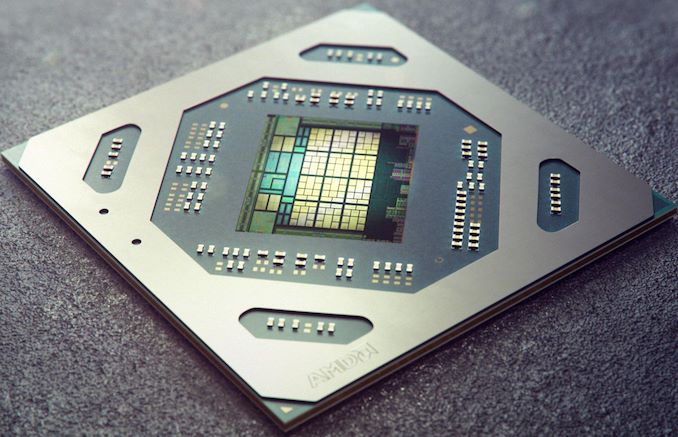
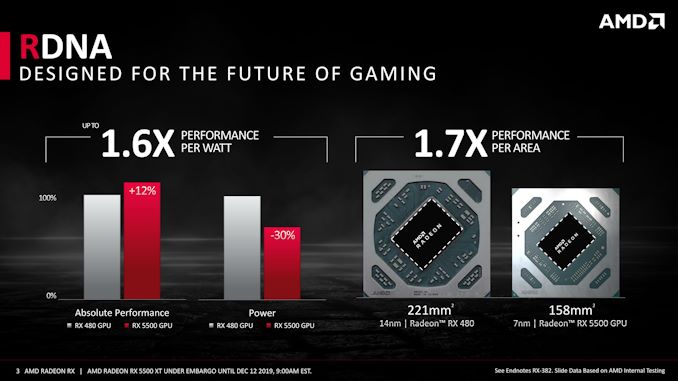
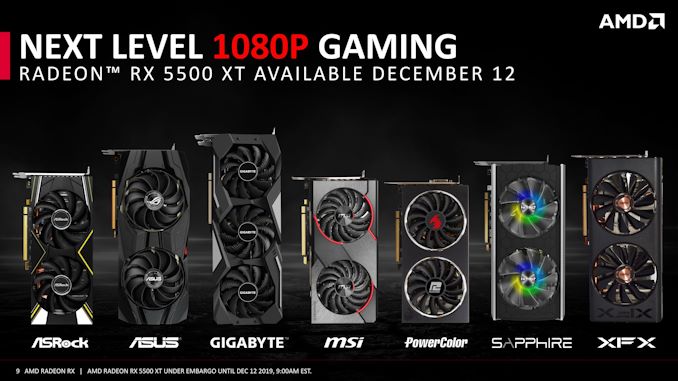




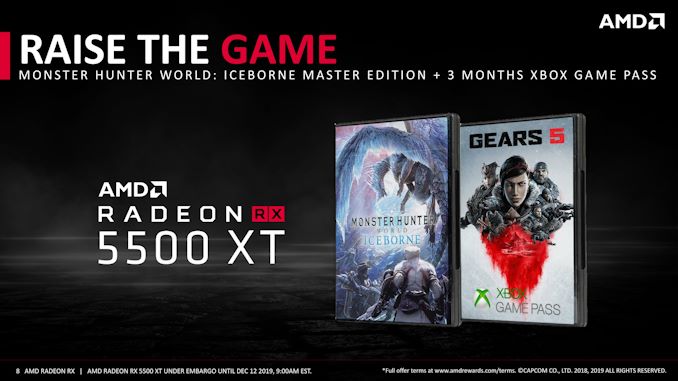








97 Comments
View All Comments
skizlock - Thursday, December 12, 2019 - link
Should be fine.TheSkullCaveIsADarkPlace - Thursday, December 12, 2019 - link
The 5500XT should be alright. But, you didn't say what you are doing, you just said what you are not doing (no gaming). So, i assume you care only about 2D. In which case you could probably select an even more inexpensive GPU that does 4K/60Hz. But then again, it's you who is calling the shots about the things you want to purchase. I am not daring to further step into the line of fire there... ;-)PixyMisa - Friday, December 13, 2019 - link
I have a 580 driving two 4K monitors for work, and it's great.Ranguvar - Thursday, December 12, 2019 - link
Hey Ryan, thank you for the excellent reviews...July 7th, you posted on the 5700 (XT) review that you had "15 pages of notes" on deeper RDNA details that you'd be posting later.
Is this ever coming to fruition? Holding out hope!
Cheers.
TEAMSWITCHER - Thursday, December 12, 2019 - link
I seriously question your motives in this review... Excluding all 1440p results, but then including the Radeon 5700 (a card priced well above this range) just to ensure that AMD has the top position in all the graphs. And your conclusion page make ZERO reference to the GTX 1660 Super card, which can be had for a very good price - $230. I'm seeing this trend all over .. tilting reviews to benefit AMD. I get it.. everyone loves an underdog... but these GPU's are just dogs.Ryan Smith - Thursday, December 12, 2019 - link
The Radeon 5700 is the next card up in AMD's current-generation stack. It's important to include it to show where the 5500 XT ends, and where the next card picks up.Fataliity - Thursday, December 12, 2019 - link
Ryan - Have you tried AMD's new performance boost on the 5500XT to see how it performs? The resolution scaling when moving screen etc? I imagine the Algo feature was built for this card, considering its release and drivers release were in sync. So I'm just wondering how it helps for a budget card?Thank you!
Ryan Smith - Thursday, December 12, 2019 - link
I've tried it. I don't care for it. But I'll give AMD tons of credit for trying new ideas.But I'll save that for once I can write up something proper.
Zoomer - Saturday, December 21, 2019 - link
Overclocking?Hrel - Thursday, December 12, 2019 - link
Nah, its pretty bs you didn't include 4k results. The ONLY reason to buy the 8gb version is 4k and now I gotta go elsewhere to find out how the gpu uses that extra vram. Very dumb not to include 4k.